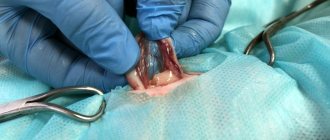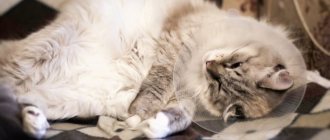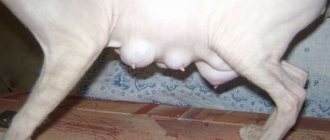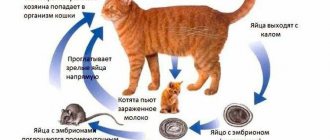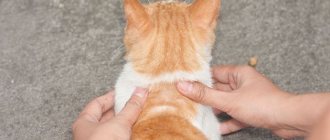10997Administration
2
Surgery to remove a cat's reproductive organs is called spaying. This procedure protects the female not only from unwanted pregnancies and problems with kittens, but also from various diseases of the ovaries and uterus.
The sterilization operation is not considered complicated; it lasts no more than 20 minutes, but is performed under general anesthesia, which can have certain consequences. Caring for a pet after surgery usually falls on the owner’s shoulders if he does not want to leave his pet in the hospital’s hospital.
Complications after sterilization of a cat can be of a different nature:
- the appearance of a lump at the site of the surgical suture;
- the female is lethargic and sleeps all the time;
- the kitten has no appetite;
- the animal screams after surgery;
- enlargement of the mammary glands;
- bowel dysfunction;
- allergy to anesthesia.
As a result of surgery, which is performed under general anesthesia, there is no guarantee that there will be no consequences.
© shutterstock
Constipation in a cat after sterilization: what to do, why it occurs
I always warn my patients: after sterilization, the cat should pee regularly, but at first there may be no stool. If after 3 days the pet does not go to the toilet in a big way, you need to take action.
There are several reasons for intestinal dysfunction. Firstly, this is a long-term starvation diet. Before anesthesia, you can feed the cat 10-12 hours. But if the operation is scheduled for the middle of the day, owners can increase this interval (do not feed the cat in the middle of the night!). Plus, the cat does not receive food for some time after the operation. As a result, she simply has nothing to poop with; it takes time for feces to form.
The second reason is the effect of drugs that are used for anesthesia in cats. Agents for intramuscular anesthesia (Domitor, Rometar, xylazine) not only significantly reduce body temperature in animals, but also affect the motility of the digestive tract. Because of this, intestinal peristalsis on the first day after surgery may be sluggish, and vomiting is possible.
The third reason for constipation after sterilization is simple stress associated with a trip to the clinic, surgery and wearing a blanket. Clothes can irritate your cat and make it difficult for you to get comfortable in the litter box.
If on the 3-4th day after the operation there is no long-awaited pile in the tray, you need to give the cat a mild laxative. It could be:
- A teaspoon of petroleum jelly (about 3 ml)
- A tablespoon of condensed milk half and half with water.
Vaseline oil is given twice a day until the cat has a bowel movement. This is liquid paraffin, the product has no taste or smell, and most importantly, it is not absorbed at all in the digestive tract. It is sold in human pharmacies, no other oil is suitable!
Possible complications
Before performing the operation, it is necessary to think about how the animal will tolerate the intervention. In some cases, complications of cat sterilization are possible. The most common of them:
- Postoperative renal failure. It may occur if the animal has an individual intolerance to the components of the anesthesia drug or is allergic. For the same reason, liver failure may occur.
- Exacerbation of diseases that the cat suffered from before surgery. These could be diseases of the cardiovascular system, pulmonary pathologies, etc.
- If a technical error was made during the procedure, this can lead to suture divergence, bleeding, and possible transection of the ureters. Another consequence may be the development of peritonitis.
- The appearance of a hernia is associated with non-compliance with the rules of postoperative care. Accidental exposure to the pathological area can cause necrosis, which can only be treated surgically.
After the operation, the cat begins to move less. Accordingly, its diet should become less caloric, otherwise the animal may become obese.
There are symptoms that the owner should pay attention to after surgery:
- inflammation at the incision site, compaction, ulcers and swelling;
- an increase in the cat's body temperature that does not go away within 4 days after surgery;
- complete loss of appetite;
- lethargy and lack of response to external stimuli;
- difficulty breathing.
If these symptoms occur, you should immediately seek help from a veterinarian to prevent the development of a life-threatening complication for the animal. If you decide to sterilize a cat, then you need to choose a clinic with a good reputation so that the operation is successful.
Trichobezoars: ingesting their own hair
For 7-14 days, depending on the doctor’s recommendation, the cat walks in a blanket or collar after sterilization. This is necessary so that she does not lick the seam. But as a result, the cat is deprived of the opportunity to wash its entire body and tidy its fur.
After the blanket is removed, the cat begins to lick itself furiously. All this time the wool fell out, became tangled under the blanket, but was not renewed. As a result, the animal swallows a huge amount of its own fur. Of course, if you have a Sphynx or Cornish Rex, there is nothing to worry about. And if the cat is a long-haired breed (Maine Coon), it must be combed with a furminator after you take off its clothes.
Trichobezoars, hairballs, are manifested either by periodic regurgitation (vomiting) or by the same constipation (see point No. 1).
Pulmonary edema in a cat after sterilization
Long gone are the days when pets were anesthetized “by eye,” and the owners begged the doctor “not to overdo it.” Now veterinary clinics have modern and safe means of anesthesia. Large clinics use inhalation anesthesia and epidural anesthesia. Despite this, general anesthesia can cause dangerous complications in cats after sterilization.
If your cat has problems with the heart muscle (hypertrophic cardiomyopathy, congenital defects), pulmonary edema or thromboembolism may develop after surgery. Both complications can lead to the death of the animal, even if the owner notices something is wrong in a timely manner and consults a doctor.
As a doctor, I recommend doing a cardiac ECHO (ultrasound) before surgery. So we can be calm or, on the contrary, look for options for anesthesia and medicinal support. In practice, owners most often refuse the study to cut costs. With the words “Yes, this is a cat, what will happen to her.” To be fair, I note that most cats do tolerate anesthesia well. But there are breeds in which HCM (hypertrophic cardiomyopathy) occurs much more often than in outbred cats. Here are some popular cats that are at risk:
- Maine Coons;
- Sphinxes;
- British cats;
- Scottish cats.
Scottish Fold ECHO of the heart is a must
Owners should monitor their cat for at least two weeks after sterilization. The pet should eat, drink, and play as usual within 24 hours. If a cat refuses to eat, lies in one place, breathes with its mouth open like a dog, you should immediately contact a well-equipped clinic for diagnosis.
Preparation is the key to successful sterilization
During the manipulation, specialists tirelessly monitor the general condition of the animal, but after the operation, the cat also requires a lot of attention from its owner. It is necessary to provide your pet with heating pads, eliminate bright light and ensure proper rest. To avoid various complications immediately after sterilization, it is customary to leave pets in the veterinary clinic until they fully recover from anesthesia.
Possible complications can be avoided by first conducting a full diagnosis of the cat’s body systems, and in particular:
- general blood analysis;
- ultrasound examination of the body;
- electrocardiogram in those cats that are at potential risk.
It is also necessary to remember that a successful result after surgery depends on proper preparation, which includes:
- timely and correctly administered vaccines (no later than 21 days before surgery);
- deworming according to timing;
- maintaining a fasting diet for 12 hours before sterilization.
This is interesting: How much will a cat’s behavior change after sterilization?
The cat's seam came apart after sterilization
A tiny cosmetic stitch after sterilization of a cat normally heals quickly without a trace. However, this is not always the case. Sometimes owners are forced to return to the clinic again because the cat’s stitch has come apart after sterilization.
The most common cause of this problem is neglect of the veterinarian's recommendations. If after surgery the cat does not wear a collar or blanket, it will tend to lick the stitches.
Together with saliva, an infection enters the wound, and severe inflammation (festering) of the suture occurs. In this case, no threads will hold the fabric together. In addition, with its rough tongue, a cat can get rid of stitches ahead of time.
If the suture discrepancy is minor, the doctor may prescribe “conservative” treatment. First of all, you need to stop the seam from licking. Then local blockades are made (Novocaine 0.5% with an antibiotic), the wound is washed 1-2 times a day. Sometimes healing ointments and preparations such as Vinilin are used. Treatments sometimes last a long time, 1-2 weeks, so I urge owners to take care of the suture immediately after surgery to avoid such problems.
Minor divergence of the cosmetic seam (the cat was not wearing a blanket)
If the suture is severely torn, the only treatment option is surgical revision of the suture under general anesthesia. The doctor will remove non-viable tissue and sew up the belly again. In this case, removable external sutures are usually placed and a systemic antibiotic is prescribed. Case from practice:
The cat was sterilized in a third-party clinic, the external and internal seams were made with silk, the cat did not wear a blanket
Severe seam divergence, 3 weeks have passed since sterilization
All non-viable tissue was removed and sutures were re-sutured.
The same cat after removal of stitches (12 days after wound revision)
Complications in cats after castration: types, symptoms, treatment
The procedure is performed under general anesthesia, the animal does not feel anything. After castration, the cat needs special care. Compliance with all before and after operating procedures minimizes the likelihood of unpleasant consequences, but does not completely eliminate them.
Complications are divided into two groups: late and early.
The latter are observed more often and include:
- painful sensations;
- digestive disorders;
- bleeding;
- self-injury, for prevention, wear a protective collar for several days;
- inflammation, suppuration, abscess;
- prolapse of parts of the internal genital organs or intestinal loop;
- wound infection.
In the normal course of events, the pain goes away after 1-2 days. Your doctor may prescribe pain medications. Digestion is restored within a week, provided you follow the diet recommended by your veterinarian. For other manifestations, the animal is taken to a veterinary clinic.
Be sure to read:
Do-it-yourself cat blanket: what is it for, what to use, what to make, step-by-step instructions on how to tie
Late complications do not appear immediately:
- problems with urination as a result of injury to the ureter;
- formation of fistulas (when using the ligature method of sterilization);
- weakening of the urethral sphincter due to hormonal changes;
- urolithiasis disease.
To avoid late severe consequences, veterinary examinations are carried out regularly.
Pain reaction after surgery
Painful sensations are the most common type of complications. Removal of the gonads is a painful procedure performed under anesthesia. After leaving the anesthesia (2-24 hours), the predator marks the territory, urination is involuntary. Urine getting on the wound causes burning and pain.
An inflammatory process accompanied by unpleasant sensations is inevitable. Pets are trying to “lick” the wound. To avoid germs and additional trauma, a special collar is worn on the neck for 3-4 days.
With severe pain, behavior becomes aggressive. To alleviate the condition, the veterinarian prescribes pain medication. If the situation worsens, the pet is taken to the doctor.
Bleeding
Liquid discharge and ichor in small quantities are normal after surgery. A trickle of blood flowing from the wound should alert you. Bleeding can also be internal; the main symptom is a swollen abdomen.
Causes:
- insufficient compression of the skin during surgery;
- hypocoagulation;
- phlebeurysm;
- incorrect ligature application;
- the biological knot is loosely tied;
- seam divergence;
- vascular sclerosis;
- improper care after sterilization.
In case of bleeding from the vessels of the scrotum, artery of the vas deferens, or the stump of the spermatic cord, repeated intervention is necessary. After identifying the source of bleeding, the doctor torses or ligates the vessel.
The animal is tested for clotting. If the test reveals hypocoagulation, I prescribe therapy.
Scrotal swelling
Enlargement of the scrotum by more than 2 times, with inflammation spreading to the foreskin, peritoneum, and high temperature indicate infection in the body. Pathogenic organisms are introduced by violating the rules of antiseptics, poor pet hygiene, or lack of walks. The progression of the infectious process is facilitated by the accumulation of dead cells in the wound. The wound heals, creating favorable conditions for the formation of an abscess.
Treatment is carried out as early as possible. The doctor removes the adhesions and exudate that has accumulated in the scrotal cavity. The wound is treated with iodine solution. To avoid secondary adhesions, the affected area is treated with boron ointment. Treatment is carried out with titrated antibacterial drugs.
Be sure to read:
After sterilization, the cat does not eat or drink for several days: what to do, what to feed
Tissue loss
In case of prolapse of the omentum, spermatic cord stump, vaginal membrane, severe infectious lesion. Tissues come into contact with microbes, and the immune response is weakened. Prolapse of the intestinal loop threatens the intestines to come out.
Treatment is surgical. The prolapsed part of the vaginal membrane or spermatic cord is amputated with an emasculator, and a ligature is first applied to the cord. The omentum is pulled out, tied with thread and cut off. The intestinal loop is set back, and the tissues that come out with it are cut off.
Inflammation of the common vaginal lining
When the testicles are removed, as a result of the reduction of the external levator testis, the tunica vaginalis is pulled upward. The shell leaves are soldered together, a cavity is formed, which is filled with exudate. Under normal conditions, the exudate resolves, but when pathogens enter, inflammation develops. The process causes an acute painful reaction.
Therapy is carried out by washing the vaginal lining with hydrogen peroxide. If necessary, remove pus and adhesions. To prevent the spread of the pathological process, a course of antibiotics is prescribed.
Inflammation of the spermatic cord stump
Funiculitis begins with an increase in the cord of the inguinal canal; upon palpation, the organ is dense and motionless. The complication appears on days 4-5.
Causes:
- violation of antiseptic rules during intervention;
- incorrect ligature application;
- formation of a hematoma in the cord;
- stump loss;
- leaving large curls when unscrewing the spermatic cord.
- Treatment consists of treatment with antiseptic agents.
Retroperitoneal abscess
Treat secondary complications. Inflammation from the spermatic cord spreads through the lymph nodes to the abdominal cavity and the walls of the bladder. The process develops rapidly: the temperature rises, the cat refuses to eat, and suddenly loses weight.
After diagnosis, antibacterial or sulfonamide drugs are prescribed. If abscesses form, surgery is performed. Subsequently, the wound is washed with antiseptics.
Rejection of suture material
Sometimes a cat's stitch may come apart after sterilization, even if she did not lick the wound. If non-sterile suture material was used during the operation, and the rules of asepsis and antisepsis were not followed, the wound may become infected.
Most often, a negative reaction occurs to non-absorbable threads (silk), too thick, coarse threads. Sometimes it is enough to remove the nodule from the wound for the reaction to stop.
If there are problems with the seam, owners notice that the cat's blanket gets wet. Or some stains or smudges appear on it. After sterilization, the seam should be clean and dry, and the skin in the wound area should be tightly closed joint to joint. If you see swelling, redness or discharge (usually this is not pus, but something like ichor) in the suture area, immediately show your pet to the surgeon. Treatment of the problem is the same as if a cat licked a seam.
Rarely, cats have a true reaction to suture material (rejection). In this case, you need to use threads made of a different material or even a special metal wire, which is removed after the tissue has healed.
Hernia after sterilization of a cat
In my practice, I have never seen a hernia occur after sterilization of a cat. This is due to the short length of the incision required to remove the uterus and ovaries. However, such a complication does occur, so I will mention it. Sterilizing a cat is a abdominal operation. The doctor must carefully stitch up the abdominal incision. A hernia occurs when the sutures fail.
A hernia looks like a protrusion under the skin in the suture area and can be of different sizes. The omentum (internal fat on ligaments) or intestinal loops fall out through a hole in the abdominal wall. The hernia definitely requires repeated surgical intervention. The operation should not be delayed to avoid the formation of adhesions or strangulation of the hernia.
Young cats will have a very small incision before their first heat.
Internal bleeding in a cat after sterilization
The veterinarian places ligatures on the vessels supplying the ovaries and uterus before removing the reproductive organs. If such a ligature comes off, internal bleeding will occur. This probability is extremely low, and many clinics use vascular electrocoagulation technology instead of threads.
Life-threatening bleeding can occur if your cat has a blood clotting disorder. This is possible with rare congenital pathologies, or with a fatal coincidence of circumstances. On a free range, a pet can catch and eat a mouse that has been poisoned but is still alive. As a result, the cat is poisoned with an anticoagulant, which leads to spontaneous bleeding.
Signs of internal bleeding:
- The cat is lethargic, weak, inactive;
- The mucous membranes (gums) are white;
- Dyspnea.
In the clinic, the diagnosis can be confirmed using an ultrasound - fluid in the abdominal cavity after surgery indicates bleeding. If ultrasound diagnosis is not possible, a diagnostic puncture of the abdominal cavity is performed with a regular syringe.
Treatment consists of blood transfusions, plasma substitutes, and the administration of hemostatic drugs. If necessary, a repeat operation is performed to find and ligate the bleeding vessel.
The cat comes to life after sterilization
Peritonitis
That is, inflammation of the peritoneum. The worst thing that can happen to a cat that has undergone surgery. Even with modern antibiotics and therapeutic techniques, purulent peritonitis is approximately a 60% guarantee of death.
The reasons are quite simple and largely overlap with the predisposing factors that we described above:
- Gross violations of the rules of asepsis and antisepsis during preparation for surgery and its implementation. You should always remember that sterilization belongs to the category of rather complex abdominal operations, and therefore the slightest deviations from the rules are fraught with major (and sometimes even fatal) problems.
- Severe cases of inflammation of postoperative sutures.
- In even rarer situations, fecal postoperative peritonitis is observed. This only happens if an extremely serious mistake was made during the operation, resulting in damage to the intestinal walls. Its contents gradually begin to leak into the abdominal cavity, which leads to the development of fecal peritonitis.
The disease ends in death in more than 90% of cases; the likelihood of cure is low.
Symptoms
We remind you that if the signs described below appear, you need to immediately take your cat to the veterinarian!
- The cat is lethargic, inactive, and remains in a kind of “daze” for a long time. She constantly sits with her paws tucked tightly under her, not reacting in any way to stimuli from the external environment (including loud noises nearby).
- You can’t even touch the pet’s belly, because, despite all its lethargy, it immediately tries to bite a person or simply break free and run away.
- Of course, the animal’s appetite disappears completely, but strong thirst remains.
- Since the pathology develops very quickly, soon the animal is no longer able to run. It only meows pitifully when you feel the stomach. The wall of the abdominal cavity is very tense (sometimes it feels like “stone”), and the local body temperature is significantly increased.
As a rule, cats that reach the last stage do not survive. So we advise you to contact a veterinarian immediately, even if you simply suspect peritonitis.
Treatment of peritonitis
Mixed. The specialist will need to perform another abdominal operation, during which the inflamed peritoneum is generously washed with antiseptic and antimicrobial drugs. Most likely, you will have to leave drainage, since washing will need to be done regularly.
The animal is also prescribed the maximum permissible doses of powerful broad-spectrum antibiotics. Often, even after treatment, the veterinarian will still have to perform another operation on the cat. This is due to the fact that adhesions often form due to peritonitis. They can only be removed surgically.
Viral infection
It is not entirely correct to call a viral infection a complication of sterilization. But I want to warn as many people as possible. Doctors try to maintain cleanliness and order in the clinic to the best of their ability. However, your cat may still encounter viruses brought in by other cats. It is better if she is vaccinated in advance. The ideal regimen is vaccination at 3 months and sterilization between 6-12 months. Then revaccination at 15 months, when the cat has fully recovered from the operation.
Alarming signs of various viral diseases (rinotracheitis, calicivirosis, panleukopenia):
- Excessive drooling;
- Ulcer on the nose, tongue;
- Nasal discharge, sneezing;
- lacrimation;
- Vomiting or diarrhea;
- Depression, refusal to eat.
If your animal feels unwell, it is better to call your doctor and discuss the course of action. Sterilization itself cannot cause poor appetite, loose stools or other symptoms.
